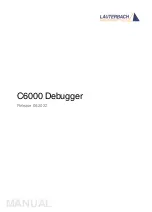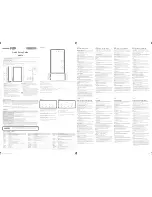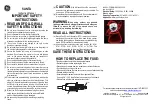
155
Glossary
App
end
ix
Glossary
Background picture
An image that disappears as the effect
progresses. The image is displayed as
the program output video before any
effect is applied.
Bus
An internal signal path to use an input
signal, color matte, etc. for a specific
purpose. Signals selected for input to
the bus are passed on to the next
process.
Chroma key
A method of creating a composite
picture by deleting components that
contain a specified color (chroma).
Typically, a subject is captured in
front of a blue background, referred
to as a “blue screen,” and the blue
background is removed, leaving only
a subject for composing.
Color bars
A test signal which displays vertical
colored stripes on a monitor. Used to
adjust the hue and saturation of colors
on video cameras and monitors.
Color matte
A color signal generated by this unit.
The hue, saturation, and luminance of
color mattes can be adjusted.
Cross-point
An electronic switch where video
signal lines cross. When the switch is
closed, usually by pressing a button,
multiple input signals and one or
more output signals are allowed to
pass.
Cut
An instantaneous switch from one
picture to another.
Downstream key (DSK)
A function which allows pictures to
be composed by taking video to
which an effect has already been
applied and adding further images
and text. It is called downstream key
because this processing is done at the
lowest stream.
Field
In the NTSC color television system,
262.5 horizontal scanning lines. Odd
lines are scanned for the first field
before returning to the top of the
screen to scan even lines. A frame is
composed of two fields: the odd and
even fields.
Foreground picture
An image that appears as the program
output video after applying any
effect.
Frame
Two fields, containing all the
information in a complete picture.
Frame synchronizer
A device or function used to bring the
timing of asynchronous video into
conformance with a local reference
signal.
Gen-lock
To synchronize output signals with
an external sync signal.
GPI (General Purpose
Interface)
A general purpose interface that is
used to communicate with devices
that do not have standard interfaces.
Luminance key
A method of creating a composite
picture by deleting components of a
specified luminance (brightness).
Typically used to extract bright
characters from a dark background,
so that only the characters can be
added to the composed picture.
Mix
A type of transition effect. A
foreground video is finally replaced
with a background video while both
videos are gradually overlapped.
Pan
To move the camera to the left and
right.
Picture-in-Picture (PIP)
An effect obtained by embedding a
video within another video.
Preset
A function which allows a set of
electrical settings to be stored and
recalled as a single set of data. This
system has a camera preset function.
Program (PGM) signal output
The final video signal output from
this system after applying the effects.
RGB
An output signal format which
displays pictures by using the three
primary colors: Red, Green, and
Blue.
Serial digital interface (SDI)
A standard for transmitting
uncompressed digital video signals
and embedded audio.
Snapshot
Data containing the settings of
specific controls on the control panel.
Snapshots can be stored and recalled
to restore the control panel to a
desired state.
Subnet mask
An IP address, which indicates the
address of a device in a network, has
two components: a network address
(the address of the network) and a
host address (the address of an
individual computer). A subnet mask
is a value used to specify how many
bits in the IP address are reserved for
the network address. A subnet is a
smaller network created by dividing a
large network into two or more parts.
S-video signal
A video signal with separate
luminance (Y) and chrominance (C)
components. As opposed to
composite video, S-video provides
higher quality by eliminating
interference between the Y and C
signals.
Tilt
To move a camera up and down.
Transition
To switch from one video to a
different video over a certain time
interval. Transitions can be used for
composing or erasing graphics or
characters using the downstream key
or Picture-in-Picture function.





































